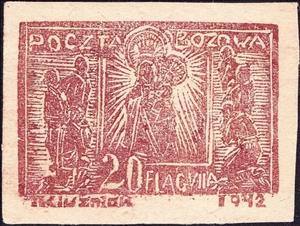Stamp: Our Lady of Czestochowa in the Camp Chapel (Poland, German Occupation In WWII 1942)
Our Lady of Czestochowa in the Camp Chapel (Poland, German Occupation In WWII 1942)
16 December (Poland, German Occupation In WWII ) within release Murnau POW Camp Oflag VII A goes into circulation Stamp Our Lady of Czestochowa in the Camp Chapel face value 20 German reichspfennig
| Stamp Our Lady of Czestochowa in the Camp Chapel in catalogues | |
|---|---|
| Polish Stamps Catalog (Fischer): | Pol: PL-PO MU 7by2A |
Stamp is square format.
After the wood sculpture by 2Lt. Szymancko. The print run number is for both the imperforate and the perforate edition of the paper variant "y2" togetherAlso in the issue Murnau POW Camp Oflag VII A:
- Stamp - Our Lady of Czestochowa in the Camp Chapel face value 20;
- Stamp - Our Lady of Czestochowa in the Camp Chapel face value 20;
- Stamp - Our Lady of Czestochowa in the Camp Chapel face value 20;
- Stamp - Our Lady of Czestochowa in the Camp Chapel face value 20;
- Stamp - Our Lady of Czestochowa in the Camp Chapel face value 20;
- Stamp - Our Lady of Czestochowa in the Camp Chapel face value 20;
- Stamp - Our Lady of Czestochowa in the Camp Chapel face value 20;
- Stamp - Our Lady of Czestochowa in the Camp Chapel - Reprint face value 20;
Stamp Our Lady of Czestochowa in the Camp Chapel it reflects the thematic directions:
Goliath (/ɡəˈlaɪəθ/ gə-LY-əth) was a Philistine giant in the Book of Samuel. Descriptions of Goliath's immense stature vary among biblical sources, with texts describing him as either 6 ft 9 in (2.06 m) or 9 ft 9 in (2.97 m) tall. According to the text, Goliath issued a challenge to the Israelites, daring them to send forth a champion to engage him in single combat; he was ultimately defeated by the young shepherd David, employing a sling and stone as a weapon. The narrative signified King Saul's unfitness to rule, as Saul himself should have fought for the Kingdom of Israel
Religion is any cultural system of designated behaviors and practices, world views, texts, sanctified places, ethics, or organizations, that relate humanity to the supernatural or transcendental. Religions relate humanity to what anthropologist Clifford Geertz has referred to as a cosmic "order of existence". Different religions may or may not contain various elements ranging from the "divine", "sacred things", "faith", a "supernatural being or supernatural beings" or "some sort of ultimacy and transcendence that will provide norms and power for the rest of life". Religious practices may include rituals, sermons, commemoration or veneration (of deities), sacrifices, festivals, feasts, trances, initiations, funerary services, matrimonial services, meditation, prayer, music, art, dance, public service, or other aspects of human culture. Religions have sacred histories and narratives, which may be preserved in sacred scriptures, and symbols and holy places, that aim mostly to give a meaning to life. Religions may contain symbolic stories, which are sometimes said by followers to be true, that have the side purpose of explaining the origin of life, the Universe and other things. Traditionally, faith, in addition to reason, has been considered a source of religious beliefs. There are an estimated 10,000 distinct religions worldwide. About 84% of the world's population is affiliated with one of the five largest religions, namely Christianity, Islam, Hinduism, Buddhism or forms of folk religion.


